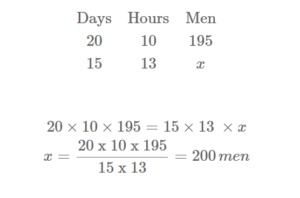Compound Proportion
“The proportion involving two or more quantities is called Compound Proportion.” The quantities could be directly related or inversely related or both.
Rules for Solving Compound Proportions

CASE-1
If quantity 1 and quantity 2 are directly related and quantity 2 and quantity 3 are also directly related, then we use the following rule:

CASE-2
If quantity 1 and quantity 2 are directly related and quantity 2 and quantity 3 are inversely related, then we use the following rule:
CASE-3
If quantity 1 and quantity 2 are inversely related and quantity 2 and quantity 3 are directly related, then we use the following rule:

CASE-4
If quantity 1 and quantity 2 are inversely related and quantity 2 and quantity 3 are also inversely related, then we use the following rule:

Example:
195 men working 10 hours a day can finish a job in 20 days. How many men are employed to finish the job in 15 days if they work 13 hours a day?
Solution:
Let x be the no. of men required

Example:
A soap factory makes 600 units in 9 days with the help of 20 machines. How many units can be made in 12 days with the help of 18 machines?
Solution:

rule of three.
- Rule of three.
- The unitary method.
Rule of three:
